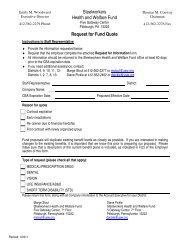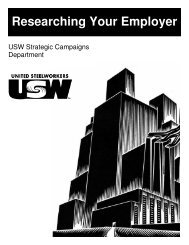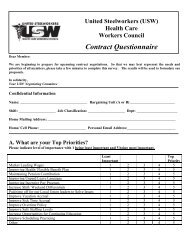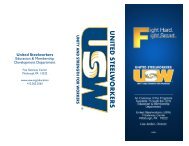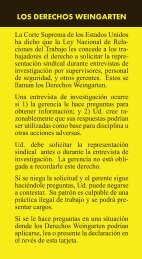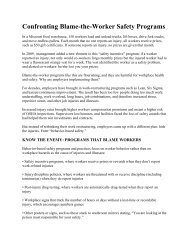Union Approach to Health and Safety: - United Steelworkers
Union Approach to Health and Safety: - United Steelworkers
Union Approach to Health and Safety: - United Steelworkers
Create successful ePaper yourself
Turn your PDF publications into a flip-book with our unique Google optimized e-Paper software.
There are alternative versions of MSDSs on the internet. Some are available<br />
in Spanish. Some sites <strong>to</strong> check are:<br />
New Jersey Hazardous Substance Fact Sheets –<br />
www.state.nj.us/health/eoh/rtkweb/rtkhsfs.htm<br />
<strong>Safety</strong> Information Resources – siri.org/msds/index.php<br />
Where <strong>to</strong> Find MSDSs on the Internet – www.ilpi.com/msds/index.html<br />
A MSDS must provide detailed information about the chemical (or chemicals<br />
if the material is a mixture). MSDSs must include the following information:<br />
o product name <strong>and</strong> ingredients;<br />
o physical <strong>and</strong> chemical characteristics (such as vapor pressure <strong>and</strong> flash<br />
point);<br />
o safety hazards, including potential for fire, explosion, <strong>and</strong> reactivity;<br />
o health hazards, including signs <strong>and</strong> symp<strong>to</strong>ms of exposure, <strong>and</strong> any<br />
medical conditions which are generally recognized as being aggravated by<br />
exposure <strong>to</strong> the chemical;<br />
o primary route(s) of entry (such as from breathing, skin contact, or eating);<br />
o OSHA permissible exposure limit, ACGIH (American Conference of<br />
Governmental Industrial Hygienists) threshold limit value, <strong>and</strong> any other<br />
exposure limit used or recommended by the chemical manufacturer;<br />
o whether the chemical is a carcinogen or potential carcinogen,<br />
o precautions for safe h<strong>and</strong>ling, including appropriate hygienic practices <strong>and</strong><br />
protective measures;<br />
o applicable control measures such as engineering controls, work practices,<br />
or personal protective equipment;<br />
o emergency <strong>and</strong> first aid procedures;<br />
o date of preparation of the MSDS; <strong>and</strong><br />
o name, address <strong>and</strong> phone number of the chemical manufacturer or other<br />
party who prepared the MSDS.<br />
Labeling: Employers must label all containers of hazardous chemicals at the<br />
workplace. Labels must give the chemical name of the material used <strong>and</strong> appropriate<br />
hazard warnings. OSHA only requires that labels be in English.<br />
Worker Training: Employers must conduct training for workers exposed <strong>to</strong><br />
chemical hazards.<br />
This training must be done at the time of workers’ “initial assignment” <strong>and</strong><br />
whenever any new chemical is introduced in<strong>to</strong> their work area.<br />
If workers do not underst<strong>and</strong> English, then the training must be conducted in a<br />
language the workers underst<strong>and</strong>.<br />
The training must explain:







